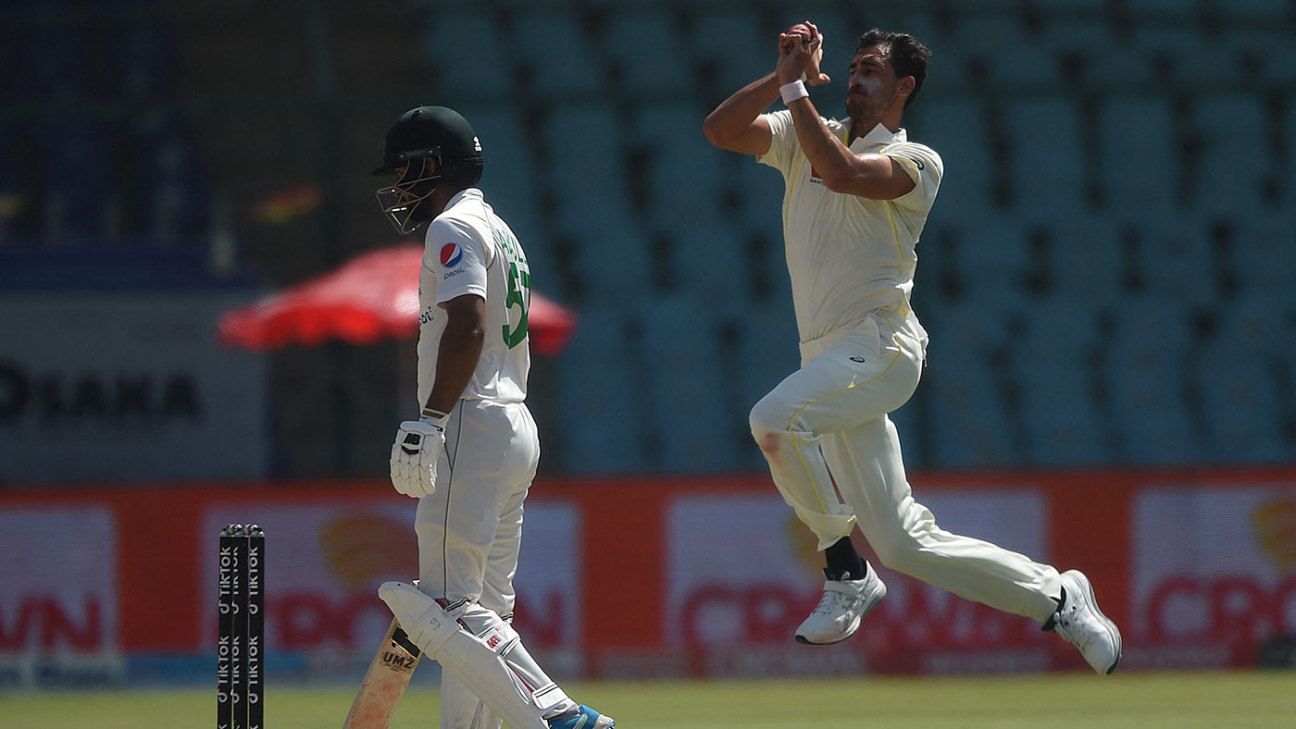Pakistan batting coach was full of praise for Starc and Cummins’ bowling, but believes the hosts can “fight and try and take it to the end”
So when, in Mitchell Swepson’s first over of Test cricket, Imam-ul-Haq took on Pat Cummins by summoning Abdullah Shafique for a tight single, it was a slightly bewildering moment. Cummins hit the stumps, as Imam only just made his ground. Pakistan had only just escaped what would have been the most embarrassing way to lose an early wicket.
Three balls later, Imam prodded one behind point, where Swepson stood poised. Babar Azam admitted before the Test they hadn’t seen much of him bowl, so there was little chance of them having a clue how good his arm was. They tried to scurry through once more, but the 28-year picked up and threw side-arm in one whirlwind motion to knock the stumps down, sending Abdullah Shafique on his way. It doesn’t require a conducive pitch to lose a wicket like that.
Imam’s dismissal shortly after, too, had little to do with the surface. Using his feet to an uncharacteristically ineffectual Nathan Lyon, the left-hander never quite got to the pitch, only managing to shovel it to long-on. The bane of Australia’s existence in Rawalpindi was going to have the afternoon off in Karachi.
“Imam scored runs in the last match by using his feet. He hit a six and a four here doing that too. It’s his strength. I feel batters score runs on their strength but can also be dismissed on it. People learn from these mistakes; it shouldn’t mean you abandon your strength.”
“The hard period was when the ball was reversing between 20 and 40 overs or so; they exploited that beautifully. Full credit to them for bowling and fielding so well.”
Yousuf on where Pakistan lost the plot
And as to why that happened became devastatingly clear to Pakistan in a match-defining 26th over. Starc’s intimidating pace and the angle from around the wicket to Azhar Ali harassed him into playing a wide delivery that was shaping away rather than in. But the piece de resistance was reserved for Fawad Alam’s first ball of the series, which had crashed into his pads before he had even appeared to get into position from his extravagantly side-on stance.
Australia had seen their opening, and they rammed right through. Between the 26th and 33rd over, Pakistan lost four wickets in 41 balls as the relentlessly brilliant Cummins partnered up with Cameron Green to leave Pakistan reeling. It was a narrow window in which the ball suddenly seemed to come into life, and while Australia on day one saw off that tricky period, Pakistan found themselves blown away.
“When such a big score is posted, the other side is under pressure,” Yousuf said. “The bowlers know they have runs on the board and can bowl with almost no pressure. Cummins and Starc bowled in fantastic areas. The hard period was when the ball was reversing between 20 and 40 overs or so; they exploited that beautifully. In that time, we lost five-six wickets.
“Full credit to them for bowling and fielding so well. You’ll have seen often that when a side posts a big total on a pitch where there’s a chance of reverse swing or turn, the team batting second faces problems, no matter how good they are.
“It’s very easy for me to tell them how to play from the outside, but when the bowling is so good and reverse swing is in play, we were taught to play only for inswing and not to take a big stride out. That’s my message to them, but it’s much easier said than done. It’s tough, because Starc and Cummins were magnificent. But you never know, sometimes a side can bat out two days. We’ll fight and try and take it to the end.”
Yousuf understood frustrations around the batters’ failure to learn, both from Australia and past mistakes, offering up a tranquil defence as suited to his game as it is to his persona.
“You always have to continue learning,” he smiled. “I try and learn something off my players, too.”
On the evidence of today’s showing, Pakistan supporters would rather the learning went the other way, for quite a while yet.
Danyal Rasool is a sub-editor at ESPNcricinfo. @Danny61000
